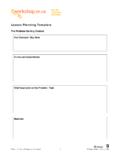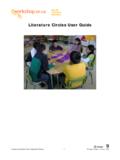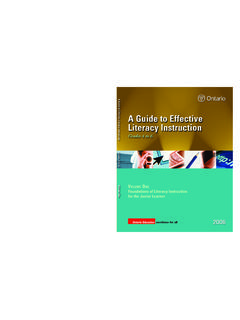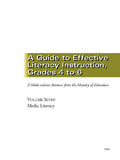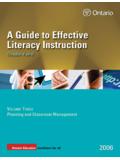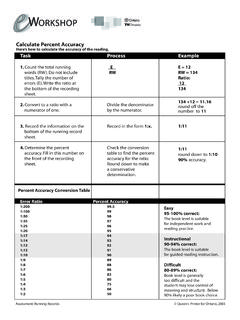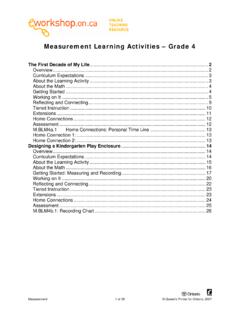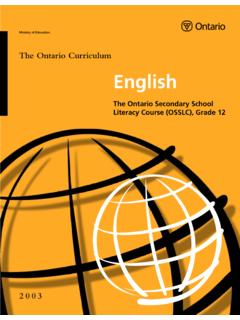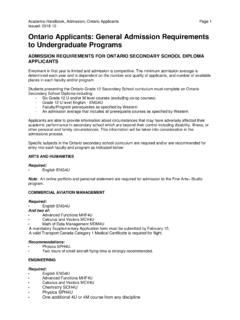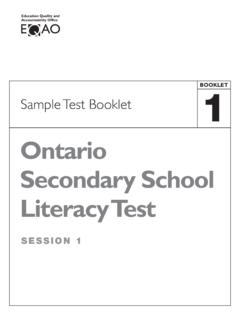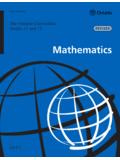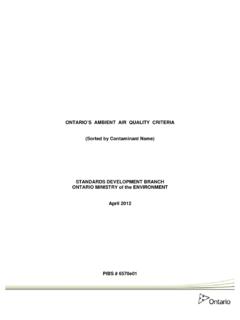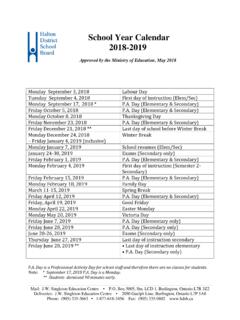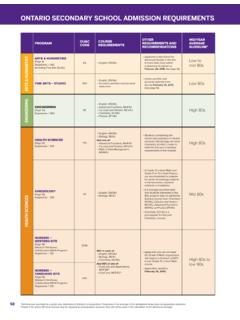Transcription of The Ontario Curriculum Grades1-8 Health and Physical …
1 The Ontario CurriculumGrades 1-8 Ministry of Educationand Training1998 Health andPhysical EducationContentsIntroduction ..2 Curriculum Expectations and Achievement Levels ..8 Healthy Living .. 10 Fundamental Movement Skills .. 20 Active Participation .. 30 Explanatory Notes .. 39 Une publication quivalente est disponible en fran aissous le titre suivant : Le Curriculum de l Ontario de la 1re la 8eann e ducation physique et sant , 1998. This publication is available on the Ministry ofEducation and Training s World Wide Web site :This version of the document was updated on October 6, 2005,to incorporate the requirement for participation in sustained moderateto vigorous Physical activity for a minimum of twenty minutes changes are being made available only in the versions of thisdocument that are on the ministry s website, and are effective as of October 6, Purpose of The Ontario Curriculum , Grades 1-8: Health and PhysicalEducation, 1998 Healthy active living involves a combination of Physical activity and appropriate lifestylechoices.
2 Students should begin early on to acquire basic knowledge about a wide variety ofhealth-related topics and to develop relevant skills. They need to understand how their actionsand decisions affect their Health , fitness, and personal well-being, and how to apply their learning to make positive, healthy decisions in all areas of life and personal development. Theschool environment can profoundly influence students attitudes, preferences, and the Health and Physical education Curriculum , students will develop: an understanding of the importance of Physical fitness, Health , and well-being and the fac-tors that contribute to them; a personal commitment to daily vigorous Physical activity and positive Health behaviours; the basic movement skills they require to participate in Physical activities throughout achievement of the objectives of the Health and Physical education program will not onlyenhance each student s life but will also result in a healthier population.
3 Students knowledgeof the importance of daily vigorous Physical activity will also help them understand how suchactivity combats Health risks such as obesity and heart comprehensive approach to Health and Physical education emphasizes the shared responsi-bility of parents, peers, schools, Health -care systems, government, the media, and a variety ofother institutions and agencies. Meaningful Health and Physical education also requires safe, Health -promoting environments, support services from the community, and a school curricu-lum that makes Health a priority in the document replaces the sections of The Common Curriculum : Policies and Outcomes,Grades 1-9, 1995that relate to Health and Physical education. All Health and Physical educationprograms for Grades 1 to 8 will be based on the expectations outlined in this Role of ParentsStudies show that students perform better in school if their parents are involved in their edu-cation.
4 Parents therefore have an important role to play in supporting their children s reading the Curriculum , parents can find out what their children are learning in each gradeand why they are learning it. This knowledge of the Curriculum will enable parents to discusstheir children s work with them, to communicate with teachers, and to ask relevant questionsabout their children s progress. Their knowledge of the expectations in each grade will alsohelp parents interpret their children s report cards and work with teachers to improve students learning. For this reason, parents are urged to read the expectations for all grades rather thanjust the particular grades their children are can also participate in parent conferences, work on school councils, and becomeinvolved in Physical activities with their children.
5 They should support classroom activities,promote and participate both in special events held within the school and in interschool activ-ities, and promote healthy active living through their own habits and practices. They shouldalso support healthy eating and take responsibility for developing their children s Role of TeachersTeachers and students have complementary responsibilities. Teachers are responsible for devel-oping a variety of appropriate instructional strategies that will involve students actively in thecurriculum and at the same time address different student needs. They should bring enthusi-asm to the classroom and should model healthy active living in their own lives to encouragestudents to recognize the value and relevance of what they are Role of StudentsStudents have responsibilities with regard to their own learning, which increase as theyadvance through elementary and secondary school.
6 Those willing to make the effort requiredand able to apply themselves soon learn that there is a direct relationship between achievementand hard work. Such students become motivated, self-directed students, however, find it more difficult to take responsibility for their learning becauseof special challenges they face. For these students, the attention, patience, and encouragementof teachers can be extremely important factors for success. Regardless of their circumstances,learning to take responsibility for their own progress and learning is an important part of edu-cation for all in the Health and Physical Education CurriculumThe Curriculum s major areas of knowledge and skills are organized around three strands: Healthy livingincludes healthy eating, growth and development, personal safety and injuryprevention, and substance use and abuse.
7 Fundamental movement skillsinclude locomotion/travelling, manipulation, and stability. Active participationincludes Physical activity, Physical fitness, living skills, and strands combine the living skills ( , personal, interpersonal, communication, conflict-resolution, goal-setting, organizational, time-management, problem-solving, and decision-making skills) that all students Importance of SafetySchools must develop procedures to ensure the highest possible level of safety, while allowingstudents to engage in a broad range of challenging activities. Safety guidelines should outlinethe practices to be followed for each activity, addressing questions related to equipment, cloth-ing, facilities, special rules and instructions, and supervision. They should also reflect schoolboard policies on how to conduct activities, and they should be reviewed on a regular all Physical activity involves an element of risk, participants have an obligation to mini-mize that Curriculum , GRADES 1-8: Health AND Physical EDUCATIONC oncern for safety should be an integral part of Curriculum planning and primary responsibility for ensuring safe practices rests with the school district and itsemployees.
8 Wherever possible, potential risks must be identified and procedures developed toprevent or minimize accidents or injuries. In a safe classroom, the teacher will be aware of up-to-date safety information, will observe students carefully, show foresight, and act implementing safe instructional practices ( , logical teaching progressions and age-appropriate activities), educators can reduce risks and guard against a safe school, students will: follow established routines for Physical activities ( , set procedures for entering and leavingthe gym and changing clothes, warm-up and cool-down activities); wear clothing appropriate to activities ( , a hat for outdoor activities), wear appropriatefootwear and ensure that shoelaces are tied, and remove jewellery when participating inphysical activities; follow the instructions outlined for each activity ( , for starting and stopping).
9 Take age-appropriate responsibility ( , for the safe use of equipment) and necessary precautions ( , use a safety mat); follow rules and expectations pertaining to the setting for the activity ( , ski only in designated areas, follow playground rules); recognize and report unsafe situations and conditions; always play in Health and Physical EducationStudents attitudes towards Health and Physical education can have a significant effect on theirachievement of the expectations. To learn effectively and develop positive attitudes towardshealthy active living, students should enjoy the skill-development and Physical activities. Theyshould also come to recognize the importance of observing safety procedures, respecting oth-ers, and being punctual. (These attitudes are incorporated into the specific expectations.)
10 The Use of Computers in the Health and Physical Education CurriculumThis Curriculum provides students with opportunities to use software programs, the Internet,e-mail, and audio and visual technology for a variety of purposes. For example, students canuse technology to record food choices over a period of time, measure nutrient intake, maintaina fitness profile, evaluate an individual s Physical stages, monitor Physical performance, anddevelop personal exercise programs. They can use the World Wide Web to access and researchinformation on various Health -and-fitness topics and Student ProgramsTeachers must provide a balanced program with a broad selection of activities. In doing so,they can combine expectations from more than one of the three strands to help students seethe connections between Physical skills and Health concepts ( , that daily Physical activityimproves Health and Physical fitness).
